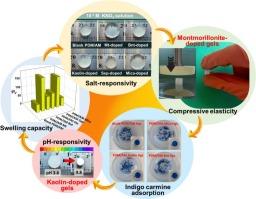Mechanistic insights for (alkyl)methacrylate-based cationic hybrid gels reinforced with sepiolite, montmorillonite, mica, bentonite and kaolin: A comparative thermodynamic study with all-in-one formulations
IF 5.8
2区 地球科学
Q2 CHEMISTRY, PHYSICAL
引用次数: 0
Abstract
A series of clay-based cationic hybrids from N,N-dimethylaminoethyl methacrylate and 2-acrylamido-2-methyl-1-propanesulfonic acid in the presence of various clays; montmorillonite (Mt), bentonite (Bnt), sepiolite (Sep), kaolin and mica was prepared by in-situ free-radical polymerization. The primary objective was to understand the macroscale properties of ionically modified (alkyl)methacrylate-based polymers reinforced with nanometer-sized clays. Water absorption, repeated on-off switching in salt solutions, elasticity and efficiency in removal of anionic indigo carmine (IC) dye, widely used in textile industry for denim production, were comparatively analyzed depending on the clay type. Compared to Sep and Mt-integrated hybrids, the mechanical property was weaker due to the inhomogeneous distribution in the structure, while the mica and kaolin-integrated gels were resistant to high compression. Mt- and Sep-addition increased the swelling by four-fold, while the swelling in the presence of mica was limited. Hybrids exhibited good salt resistance and pH-sensitive swelling, with largest change in the volume being observed in Mt-doped gels, while least change was in Kaolin-doped ones. Based on the effect of salinity, the swelling of hybrids in aqueous solutions of monovalent and divalent metal nitrates followed the decreasing order as KNO3 > NaNO3 > Ba(NO3)2. Regardless of clay type, hybrid cryogels prepared at low polymerization temperature followed Fickian diffusion, while at higher temperatures, the clay type altered the mechanism and non-Fickian diffusion was observed in hybrid hydrogels doped with Mt, kaolin and mica. Anionic IC adsorption, which reached equilibrium in 30 min, varied between 93.4 % and 97.6 %. The presence of Kaolin and Bnt caused a significant increase in adsorption, while a decrease was observed in presence of Sep. Adsorption isotherms determined by three parameter models were compared with two-parameter models in linear and non-linear fitting of equilibrium data; Freundlich isotherm model and pseudo-first order kinetic model had the best fitness. Comparative results demonstrated that clay-integrated (alkyl)methacrylate-based cationic hybrids can be employed as effective and economical adsorbents for removal of anionic dyes from aqueous environments.

由海泡石、蒙脱土、云母、膨润土和高岭土增强的(烷基)甲基丙烯酸酯基阳离子杂化凝胶的机理:一项综合配方的热力学比较研究
N,N-二甲氨基甲基丙烯酸乙酯和2-丙烯酰胺-2-甲基-1-丙磺酸在不同粘土存在下的一系列粘土基阳离子杂化物采用原位自由基聚合法制备蒙脱土(Mt)、膨润土(Bnt)、海泡石(Sep)、高岭土和云母。主要目的是了解纳米粘土增强的离子改性(烷基)甲基丙烯酸酯基聚合物的宏观性能。对纺织工业中广泛应用于牛仔布生产的阴离子靛蓝胭脂红染料(IC)的吸水性、在盐溶液中的反复开关性、弹性和去除率进行了不同粘土类型的对比分析。与Sep和mt相结合的凝胶相比,由于结构中的不均匀分布,其力学性能较弱,而云母和高岭土相结合的凝胶具有抗高压缩性能。Mt-和sep -的加入使溶胀增加了4倍,而云母的存在则限制了溶胀。杂化物表现出良好的耐盐性和ph敏感性溶胀,掺杂mt凝胶的体积变化最大,而掺杂高岭土凝胶的体积变化最小。受盐度影响,杂化产物在一价和二价金属硝酸盐水溶液中的溶胀程度依次为KNO3 >; NaNO3 > Ba(NO3)2。无论粘土类型如何,在低聚合温度下制备的杂化冷凝胶遵循菲克氏扩散,而在较高温度下,粘土类型改变了机理,在掺杂Mt、高岭土和云母的杂化水凝胶中观察到非菲克氏扩散。阴离子IC吸附在30 min内达到平衡,在93.4% ~ 97.6%之间。高岭土和Bnt的存在使吸附量显著增加,而Sep的存在使吸附量减少。对平衡数据进行线性和非线性拟合,比较了三参数模型和两参数模型确定的吸附等温线;Freundlich等温模型和拟一级动力学模型适合度最好。对比结果表明,粘土集成(烷基)甲基丙烯酸酯基阳离子杂化物可以作为一种经济有效的吸附剂用于去除水中环境中的阴离子染料。
本文章由计算机程序翻译,如有差异,请以英文原文为准。
求助全文
约1分钟内获得全文
求助全文
来源期刊

Applied Clay Science
地学-矿物学
CiteScore
10.30
自引率
10.70%
发文量
289
审稿时长
39 days
期刊介绍:
Applied Clay Science aims to be an international journal attracting high quality scientific papers on clays and clay minerals, including research papers, reviews, and technical notes. The journal covers typical subjects of Fundamental and Applied Clay Science such as:
• Synthesis and purification
• Structural, crystallographic and mineralogical properties of clays and clay minerals
• Thermal properties of clays and clay minerals
• Physico-chemical properties including i) surface and interface properties; ii) thermodynamic properties; iii) mechanical properties
• Interaction with water, with polar and apolar molecules
• Colloidal properties and rheology
• Adsorption, Intercalation, Ionic exchange
• Genesis and deposits of clay minerals
• Geology and geochemistry of clays
• Modification of clays and clay minerals properties by thermal and physical treatments
• Modification by chemical treatments with organic and inorganic molecules(organoclays, pillared clays)
• Modification by biological microorganisms. etc...
 求助内容:
求助内容: 应助结果提醒方式:
应助结果提醒方式:


